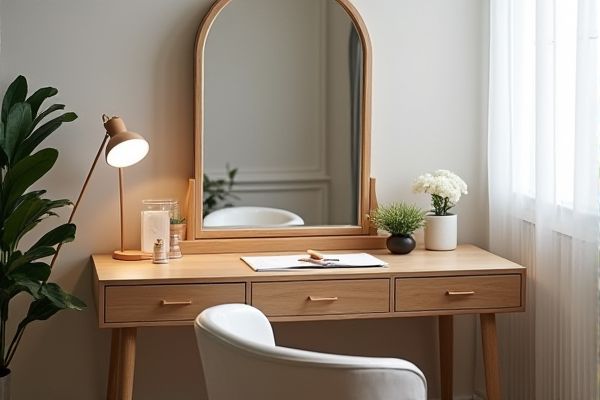
Vanity tables are designed primarily for grooming and makeup application, featuring mirrors and storage for beauty products, while writing desks focus on providing a flat surface and organization for writing and office tasks. Understanding these key differences can help you choose the right piece of furniture for your space and needs--continue reading to explore the features, benefits, and styles of both vanity tables and writing desks.
Table of Comparison
| Feature | Vanity Table | Writing Desk |
|---|---|---|
| Primary Use | Makeup application and grooming | Writing, reading, and office work |
| Design | Includes mirror and storage for cosmetics | Flat surface with drawers for stationery |
| Storage | Small compartments for makeup, jewelry | Drawers for papers, pens, office supplies |
| Seating | Often paired with cushioned stool | Typically paired with ergonomic chair |
| Location | Bedroom or dressing area | Office or study room |
| Lighting | Integrated or nearby vanity lights | Task lighting or desk lamps |
| Common Materials | Wood, glass, mirrors | Wood, metal, laminate |
| Typical Size | Compact to medium-sized | Varies, often larger for work space |
Introduction: Vanity Table vs Writing Desk
A vanity table is designed primarily for grooming and makeup application, featuring mirrors and storage for beauty products, while a writing desk emphasizes workspace with drawers and a flat surface for writing or computer use. Your choice depends on functionality needs: vanity tables enhance personal care routines, whereas writing desks support productivity and organization. Both pieces serve distinct purposes and can complement different room aesthetics.
Design and Aesthetic Differences
Vanity tables often feature ornate designs, mirrors, and compartments tailored for cosmetics, emphasizing elegance and personal grooming, while writing desks prioritize functionality with flat surfaces, drawers, and minimalist styles suited for work or study. The aesthetic of a vanity table leans towards decorative and luxurious, incorporating materials like polished wood, glass, and intricate detailing that complement bedroom decor. Your choice depends on whether you want a piece that enhances beauty routines or provides a practical workspace with a streamlined, professional appearance.
Primary Functions and Uses
A vanity table primarily serves as a personal grooming station equipped with a mirror and storage for cosmetics, jewelry, and beauty tools, designed to facilitate daily skincare and makeup routines. In contrast, a writing desk is intended for tasks such as writing, reading, and managing paperwork, often featuring ample surface space and drawers for stationery and office supplies. While both pieces of furniture provide functional storage, their design and purpose distinctly cater to personal grooming versus productivity and organization.
Storage Options Compared
Vanity tables typically offer specialized storage compartments such as multiple small drawers, trays, and compartments designed for organizing makeup, skincare products, and jewelry, catering specifically to personal grooming needs. Writing desks, on the other hand, generally feature larger drawers and flat surfaces optimized for paperwork, laptops, and office supplies, emphasizing functional workspace over cosmetic storage. The choice between a vanity table and a writing desk hinges on whether the primary requirement is for beauty product organization or efficient office storage solutions.
Material and Style Variations
Vanity tables typically feature materials such as wood, wrought iron, or acrylic, often adorned with ornate carvings, mirrored surfaces, and luxurious finishes that emphasize elegance and femininity. Writing desks prioritize functionality with materials like solid wood, metal, or engineered wood, showcasing minimalist, mid-century modern, or industrial styles designed for productivity and durability. Both furniture types offer diverse style variations, but vanity tables lean towards decorative aesthetics while writing desks emphasize practicality and ergonomic design.
Space Requirements and Placement
Vanity tables generally require more dedicated space due to their larger mirrors and storage for beauty products, making placement near natural light sources ideal for makeup application. Writing desks typically have a more compact footprint, designed for functional use such as paperwork or computer work, allowing for flexible placement in smaller areas. Your choice depends on available room size and whether the primary function emphasizes grooming or productivity.
Ergonomics and Comfort
Vanity tables emphasize ergonomics tailored for personal grooming, often featuring adjustable mirrors and cushioned seating to enhance comfort during beauty routines. Writing desks prioritize proper posture support with ergonomic chair compatibility, spacious surfaces, and organized layouts to minimize strain during extended work sessions. Your choice should align with your primary activity to ensure optimal comfort and posture support throughout use.
Price Range and Affordability
Vanity tables typically range from $150 to $800, with affordable models often made from MDF or particleboard, while higher-end versions incorporate solid wood and built-in lighting, increasing the price. Writing desks generally cost between $100 and $1,200, with budget-friendly options available in metal or laminate and premium designs featuring hardwood and ergonomic features driving up costs. Both furniture types offer budget to luxury choices, but writing desks tend to have a wider price range due to varied materials and functional designs.
Versatility and Adaptability
A vanity table offers specialized storage and design tailored for makeup and grooming, making it ideal for personal care routines. Writing desks provide versatile workspaces that accommodate computers, paperwork, and creative projects, adapting to home office or study needs. Your choice depends on whether you prioritize beauty organization or multifunctional workspace adaptability.
Choosing the Right Table for Your Needs
When choosing between a vanity table and a writing desk, consider the primary function you want the table to serve, as a vanity table is designed for beauty routines with mirrors and storage for cosmetics, while a writing desk is optimized for productivity and organization with flat surfaces and drawers for office supplies. Your available space and aesthetic preferences also play a crucial role; vanity tables often feature decorative elements ideal for bedrooms, whereas writing desks have sleek designs suited for home offices. Prioritizing your daily activities and storage requirements will help you select the right table that enhances both functionality and style in your living area.
 homyna.com
homyna.com